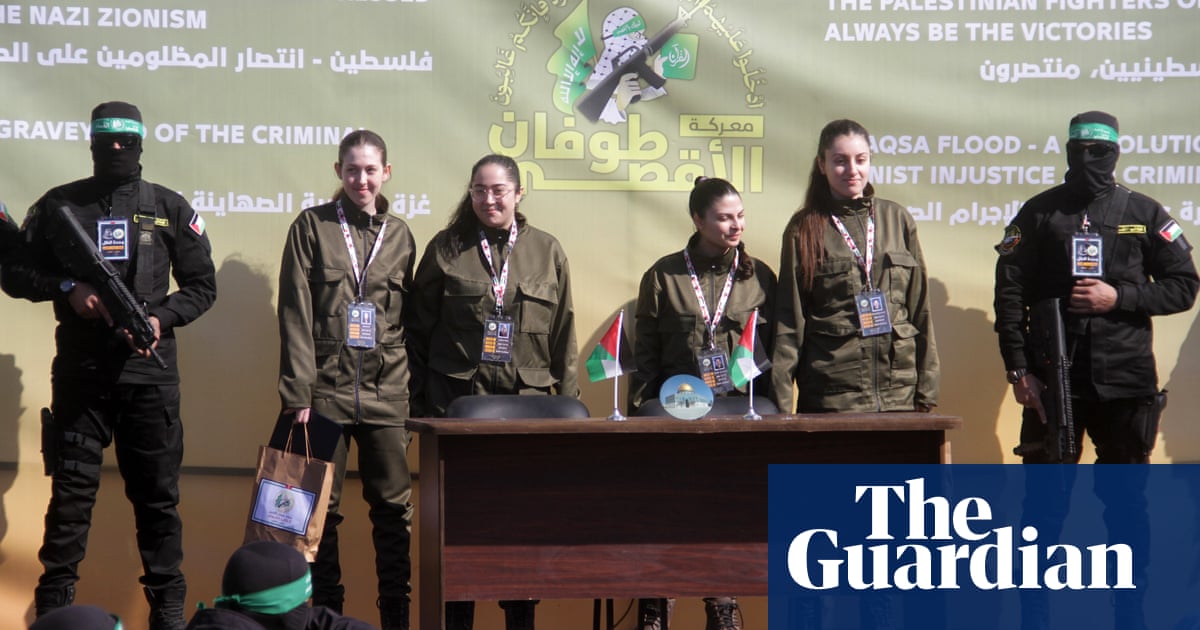 |
|
The release of four Israeli soldiers held captive in Gaza for fifteen months has been met with jubilant celebrations in both Gaza City and Tel Aviv. The handover, a complex and tense event, unfolded in Palestine Square, Gaza City, where hundreds of people gathered amidst the rubble and flags of various Palestinian militant groups. The soldiers, Karina Ariev, Daniella Gilboa, Naama Levy, and Liri Albag, appeared briefly on a podium, smiling and holding hands, before being transported by the International Committee of the Red Cross to be flown to Israel. Their appearance, marked by smiles and a thumbs-up gesture, contrasted sharply with the grim reality of their prolonged captivity and the ongoing conflict.
In Tel Aviv, families of Israeli hostages gathered, watching the live footage of the handover with a mixture of relief and joy. Tears of happiness and cheers filled the air, punctuated by the waving of Israeli flags and the display of pictures of other captives still held in Gaza. The atmosphere underscored the emotional toll of the conflict on the families, highlighting the hope and anxiety interwoven within the event. The visible presence of masked, uniformed fighters from Hamas and Palestinian Islamic Jihad, the groups responsible for the soldiers' capture, served as a stark reminder of the ongoing tensions and the precarious nature of the peace. Their display of military might, featuring shiny white cars adorned with flags and automatic weapons, was a demonstration of their strength even as they participated in the release.
The release of the four soldiers took place amidst the larger backdrop of the ongoing conflict between Israel and Palestine. This conflict, which began on October 7, 2023, has resulted in devastating losses on both sides. More than 47,000 Palestinians have died in the subsequent Israeli assault on the Gaza Strip, marking the longest war in Israel's history. On the Israeli side, over 1,300 people were killed and 250 taken hostage in the initial Hamas attack. The soldiers, members of an all-female IDF surveillance unit, were captured at the Nahal Oz base near the Gaza border. Their capture occurred after they reported suspicious activity by Hamas militants preparing for their devastating assault on Israeli towns and kibbutzim, reports which were unfortunately ignored until it was too late.
The release of the soldiers also highlighted the complexities of the ongoing negotiations and the fragility of the ceasefire. There was a brief period of uncertainty when Hamas initially announced their intention to release only the female soldiers, raising concerns that the ceasefire agreement had been breached. Israeli media reported that security officials initially considered this a violation but ultimately decided to proceed with the exchange. The continued captivity of other Israelis, both military personnel and civilians, remains a major point of contention. Israeli sources estimate that between one-third and one-half of the remaining 90 captives are still alive, generating immense pressure on the Israeli government to secure their release.
The case of Arbel Yehoud, a German-Israeli citizen, exemplifies the intricacies of the hostage situation. Her captivity by Palestinian Islamic Jihad, rather than Hamas, complicates her potential release. While Al Jazeera reported that Palestinian sources confirmed she is alive, her situation underscores the multifaceted nature of the conflict and the various actors involved. Similarly, the family of Shiri Bibas, a civilian hostage captured with her husband and two young children, expressed their disappointment at her exclusion from the current release. Their statement highlighted the ongoing anguish and uncertainty faced by families still awaiting the return of their loved ones. The Bibas family's plight underscores the human cost of the conflict and the continued suffering of those left behind.
The release of the four soldiers is a significant event, offering a glimmer of hope amid the devastation. However, it also serves as a stark reminder of the numerous challenges that lie ahead in resolving the conflict. The ongoing negotiations, the continued captivity of other Israelis, and the immense human cost of the war all demand continued attention and effort to achieve a lasting resolution. The future remains uncertain, but the release of the soldiers represents a step forward, albeit a small one, in a long and arduous process. The jubilation in both Gaza and Tel Aviv stands as a testament to the human desire for peace and the deep longing for reunification amidst immense suffering. The path to a comprehensive resolution will undoubtedly be complex and challenging, requiring extensive diplomatic efforts and a commitment from all parties involved to prioritize peace and the well-being of those impacted by this devastating conflict.
Source: Jubilant scenes in Gaza City as four Israeli soldiers are released
